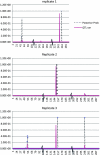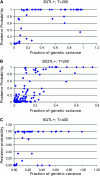Accurate prediction of genetic values for complex traits by whole-genome resequencing
- PMID: 20308278
- PMCID: PMC2881142
- DOI: 10.1534/genetics.110.116590
Accurate prediction of genetic values for complex traits by whole-genome resequencing
Abstract
Whole-genome resequencing technology has improved rapidly during recent years and is expected to improve further such that the sequencing of an entire human genome sequence for $1000 is within reach. Our main aim here is to use whole-genome sequence data for the prediction of genetic values of individuals for complex traits and to explore the accuracy of such predictions. This is relevant for the fields of plant and animal breeding and, in human genetics, for the prediction of an individual's risk for complex diseases. Here, population history and genomic architectures were simulated under the Wright-Fisher population and infinite-sites mutation model, and prediction of genetic value was by the genomic selection approach, where a Bayesian nonlinear model was used to predict the effects of individual SNPs. The Bayesian model assumed a priori that only few SNPs are causative, i.e., have an effect different from zero. When using whole-genome sequence data, accuracies of prediction of genetic value were >40% increased relative to the use of dense approximately 30K SNP chips. At equal high density, the inclusion of the causative mutations yielded an extra increase of accuracy of 2.5-3.7%. Predictions of genetic value remained accurate even when the training and evaluation data were 10 generations apart. Best linear unbiased prediction (BLUP) of SNP effects does not take full advantage of the genome sequence data, and nonlinear predictions, such as the Bayesian method used here, are needed to achieve maximum accuracy. On the basis of theoretical work, the results could be extended to more realistic genome and population sizes.
Figures


 ).
).
References
-
- Erickson, D. L., C. B. Fenster, H. K. Stenoien and D. Price, 2004. Quantitative trait locus analyses and the study of evolutionary process. Mol. Ecol. 13 2505–2522. - PubMed
-
- Goddard, M. E., 2009. Genomic selection: prediction of accuracy and maximisation of long term response. Genetica 136 245–257. - PubMed
MeSH terms
LinkOut - more resources
Full Text Sources

